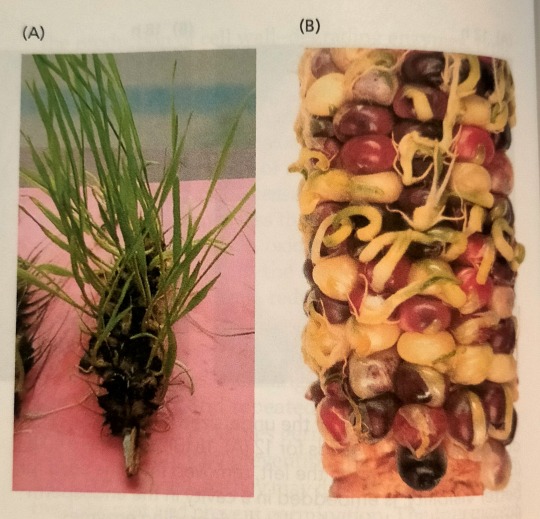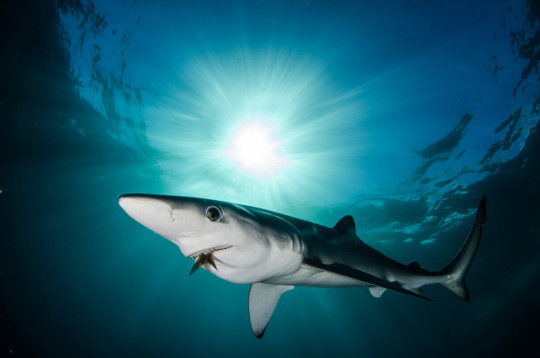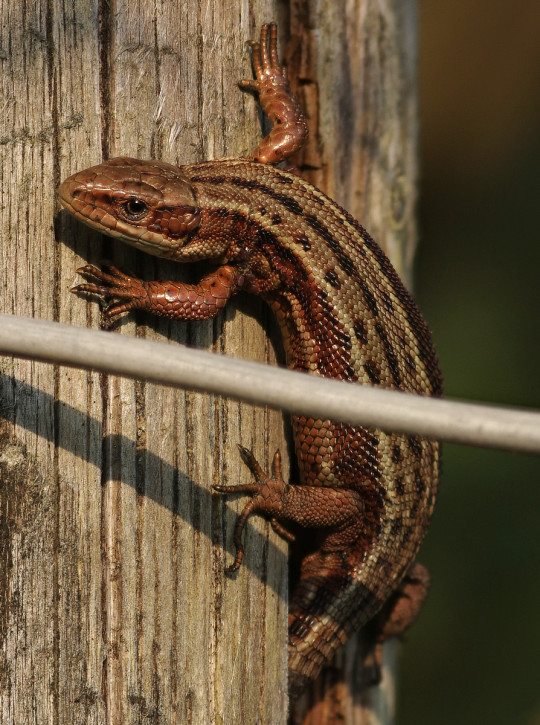#viviparous
Explore tagged Tumblr posts
Text
I didn't know rabbits are this fertile. 🐇
(Source)
2 notes
·
View notes
Text
Reproduction system is ready!
Mitosis
Viviparous
Oviparous
#gamedev#procedural#game#sim#planet#simulation#indiedev#solodev#videogame#game development#creatures#reproduction#viviparous#oviparous#mitosis
11 notes
·
View notes
Text
The germination of physiologically mature seeds on the mother plant is known as preharvest sprouting and is characteristic of some grain crops when they mature in wet weather (Figure 18.4A). (...) In maize, viviparous (vp) mutants have been selected in which the embryos germinate directly on the cob while still attached to the parent plant, referred to as precocious germination (Figure 18.4B).


"Plant Physiology and Development" int'l 6e - Taiz, L., Zeiger, E., Møller, I.M., Murphy, A.
#book quotes#plant physiology and development#nonfiction#textbook#germination#preharvest sprouting#wet weather#maize#corn#zea mays#precocious germination#viviparous#vivipary#mutation#mutants#vp#wheat#triticum aestivum#xanthoxin#aba#abscisic acid
5 notes
·
View notes
Text

Oreina alpestris Canon 400D EF 100 2.8 f/2.8 1/126 iso: 400 Srbsko, Czech Republic 8/15/2010
#beetles#Chrysomelidae#Coleoptera#leafbeetles#viviparous#insects#invertebrates#macro#insectphotography#macrophotography#insect#canon#grasslands
0 notes
Video
Common lizard, with her young. Firfisle, mor med unge by Harald Bøhn Via Flickr: "Nordfirfisle også kalt bare firfisle (Zootoca vivipara). Det vitenskapelige navnet var inntil nylig Lacerta vivipara, men arten er nå plassert i den monotypiske slekten Zootoca. Vivipara hentyder til at denne arten føder levende unger. Dette er ikke helt riktig, men nordfirfisla er ovovivipar. Dette innebærer at eggene blir klekket samtidig som hunnen legger dem. Dette er en tilpasning som er vanlig blant krypdyr som lever i kaldt klima: Ungene kan utvikle seg raskere dersom de oppholder seg lengst mulig i kroppen til hunnen fordi hun velger å oppsøke varme steder. Faktisk er alle norske krypdyr, unntatt buormen, ovovipare. Antall unger hos nordfirfisla varierer fra to til ti, og de er 4 - 4,5 cm ved «fødselen». Det første året er ungene ensfarget mørke, ofte helt svarte. Når de er årsgamle, får de den voksne brune fargen med tegninger. Maksimallengden er 17 - 18 cm, og hunnen er gjerne noe større enn hannen. Om vinteren går nordfirfisla i dvale." Sitat Wikipedia no.wikipedia.org/wiki/Nordfirfisle "The viviparous lizard or common lizard (Zootoca vivipara, formerly Lacerta vivipara) is a Eurasian lizard. It lives farther north than any other reptile species, and most populations are viviparous (giving birth to live young), rather than laying eggs as most other lizards do. The name of the species is derived from its ability to give birth to live young, an adaptation to a cool climate – but some southern populations are oviparous (egg-laying). The 3-10 young (or eggs) are usually produced in July. The blackish young measure about 3 cm, and when first born are surrounded by egg membrane, from which they break free after about a day." From Wikipedia en.wikipedia.org/wiki/Viviparous_lizard
1 note
·
View note
Text



Viviparous lizard/skogsödla. Värmland, Sweden (August 1, 2019).
565 notes
·
View notes
Text




Лучше попугая на плече только лесная гостья-живородящая ящерица (лат. Zootoca vivipara). Май 24. The only thing better than a parrot on the shoulder is the forest guest-viviparous lizard (lat. Zootoca vivipara). May 24.
#русский tumblr#Россия#природа#весна#загородом#лес#пресмыкающиеся#живородящая ящерица#солнечныйдень#мои фото#Russia#nature#nature photography#spring#sunny day#forest#reptiles#viviparous lizard#Zootoca vivipara#my photos#nature photopragpy#original photography#photographers on tumblr
184 notes
·
View notes
Text

Wall lizard (Podarcis muralis) ; Sand lizard (Lacerta agilis) ; Viviparous lizard (Zootoca vivipara)
Reptiles and Amphibians of the World. Written by Hans Hvass. Illustrated by Wilhelm Eigener. Originally published in 1958.
Internet Archive
152 notes
·
View notes
Text
Daily fish fact #582
Blue shark!

They are viviparous, which means the embryo develops inside the mother instead of developing in an egg! A female can have anywhere from 4 to a whopping 135 pups, but most commonly they tend to have 25 to 50 pups.
#i like explaining these terms because i always mix up viviparity and oviparity#fish#fishfact#fish facts#fishblr#marine biology#marine life#marine animals#sea animals#sea creatures#sea life#biology#zoology#shark#sharks#blue shark
194 notes
·
View notes
Text

Viviparous lizard! Its name comes from the Latin words for “live birth” - unusually for reptiles, they give birth to live young most of the time instead of laying eggs!
[ID: an illustration of a light brown lizard with darker and lighter brown speckled markings, curled to the left on a light green background. It is surrounded by pink flowers and petals. End.]
193 notes
·
View notes
Text
If rellana x messmer was requited and they were together, one of them would def get pregnant and it wouldn't be rellana...
#you know how it is#vipers are viviparous which means he would birth live young#elden ring#rellana#messmer the impaler#messmer x rellana
40 notes
·
View notes
Text
Day 51 of posting cute creatures we found on our field trip:

Viviparous lizard (Zootoca vivipara) is the smallest European lizard. This is an adult female, they don’t get bigger than this. These lizards prefer to live in cold climate and on high mountains. They can be found in Scandinavia and Northern Europe, the Alps and all mountain ranges in Balkans. They adapted to cold climate and long winters by live bearing and being tiny.
This is the last creature we found! I hope you enjoyed this “series” and fun facts about all the animals we met.
21 notes
·
View notes
Text

Catching the last few rays at sunset.
25 notes
·
View notes
Text
For example, a loss-of-function mutation in the maize gene DEFECTIVE KERNEL1 (DEK1) results in the production of seeds without aleurone layers (compare Figure 21.28A and B). When the VIVIPAROUS1 (Vp1) gene promoter, which is expressed specifically in the aleurone layer, was fused to the GUS gene and used as a reporter for the aleurone cells (Vp1:GUS transgene), the wild-type grain containing the transgene showed the blue color reaction indicating the presence of the aleurone layer (Figure 21.28C), whereas the dek1 mutant seed containing the same transgene did not (Figure 21.28D).

"Plant Physiology and Development" int'l 6e - Taiz, L., Zeiger, E., Møller, I.M., Murphy, A.
#book quotes#plant physiology and development#nonfiction#textbook#mutants#mutation#maize#corn#zea mays#dek1#defective kernel#seeds#aleurone#viviparous#vp1#glucuronidase#gus#transgene#plant cells
1 note
·
View note
Text

A viviparous lizard (Zootoca vivipara) in Sweden
by Hanna Knutsson
#viviparous lizard#lizards#reptiles#zootoca vivipara#zootoca#lacertidae#squamata#reptilia#chordata#wildlife: sweden#wildlife: europe
84 notes
·
View notes
Text


Viviparous lizard/skogsödla. Värmland, Sweden (July 21, 2020).
241 notes
·
View notes